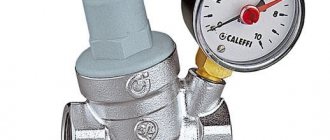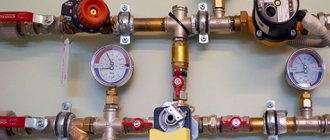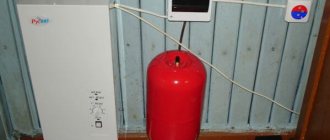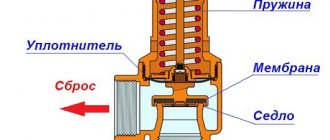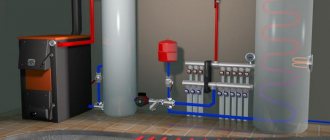Is this normal or a sign of serious problems? Causes of pressure drop in the heating system
Most household heating systems depend on the pressure and temperature conditions of the coolant .
Heating works by running heated fluid through pipes and radiators, delivering heat throughout the house thanks to pressure differences in the system.
However, the difference can fail, which requires its adjustment to a smaller or larger direction. This procedure is necessary to restore operational efficiency and maintain safety during its operation.
Standards for pressure drop in the heating system of a private and apartment building
Drop standards are regulated by GOST and SNiP rules. The above documentation calculations ensure full operation of the entire heating equipment system, including the following facilities:
- one-story building - 0.1-0.15 MPa or 1-1.5 atmospheres;
- low-rise building ( maximum three floors ) - 0.2-0.4 MPa or 2-4 atm.;
- apartment building with an average number of floors ( 5-9 floors ) - 0.5-0.7 MPa or 5-7 atm.;
- high-rise apartment buildings - up to 10 MPa or 10 atm.
The difference itself should be 0.2-0.25 MPa or 2-2.5 atmospheres.
Why does pressure fluctuate and when does it not occur?
A special surge is needed so that the coolant does not stagnate in one place , but constantly circulates between the direct pipeline of the boiler room (during supply) and the radiators of the house (during reverse flow). Thanks to the difference of 2.5 atmospheres , the coolant “runs” at a speed that stably maintains a comfortable temperature.
If the pressure is insufficient, the heating devices do not receive effective heat transfer from the coolant liquid and the room becomes cold.
Pressure value in the heating system of a private house
In a heating system, one of the most important indicators is pressure. It affects the performance of equipment and determines how efficient heat transfer is.
Only if the indicators of the force with which the water presses correspond to the norm can we talk about the high-quality operation of the heating network. The speed of water depends on the level of pressure. The higher it is, the faster the flow moves, and, accordingly, the more efficient the heat transfer. A high indicator guarantees the delivery of water to all rooms with minimal temperature loss.
If the pressure is not strong enough, the water heated in the boiler will move too slowly through the elements of the heating system, which will lead to it entering living spaces at a temperature much lower than at the exit from the boiler. Low pressure leads to significant heat loss.
There are two types of pressure in the heating network, static and dynamic. In the first case, we are talking about the force with which a column of water at rest presses on the boiler, pipeline and radiator. This indicator depends on the height. With every 10 meters it increases by 1 Atm. Dynamic pressure refers to the force applied to the elements of a system by a fluid that is moving.
The sum of the static and dynamic pressure indicators determines how efficient the system is and is called the operating pressure.
Calculation method
There are two types of pressure in a central heating system :
- pressure testing : temporary, with increased load, which is created to test the system after repair and installation work or before the heating season;
- operating : constant, at which the system should function perfectly throughout the heating period.
To correctly calculate the pressure drop, you need to take into account the difference between two points of the heating circuit: on the top floor and the bottom. The final indicator with a functioning pressure should not exceed 10% , and with a pressure test - 20%.
Typically, in a city multi-storey building, the working pressure on the supply pipe is 6 atmospheres, and on the return path - 4-4.5 atm.
Reference. The pressure indicator is influenced by many factors, including clogging of the internal channels of the circuits.
For private houses, a critical indicator is the power of the boiler, i.e. the level of pressure that the unit can withstand. Usually, 2-3 atmospheres is quite enough for a one-story house.
Regulator for pressure regulation
To comply with all measures for the safe operation of the heating system, it is necessary to constantly monitor the temperature and pressure of the coolant.
The pressure is monitored using a Bourdon tube pressure gauge . This device has an elastic measuring component, which, under the influence of a compressive load, is deformed in a certain way.
Photo 1. Pressure gauge installed in the heating system. The device allows you to measure pressure readings.
The conversion of changes is reflected in the rotational movement of the hand , showing the exact value on the dial in familiar terms.
Important! After water hammer, pressure gauges need to be checked, as subsequent readings may be too high.
Pressure gauges are installed in the most critical areas of the system:
- at the inlet and outlet of the coolant line (centralized heating);
- before and after the heating boiler (individual heating);
- before and after the circulation pump (forced circulation);
- near filters, related regulators and valves.
Causes of pressure drop and ways to eliminate them
Among the main reasons for the drop in pressure are the following:
- leak ;
- reducing the volume of the radiator by eliminating the air masses contained in it;
- decrease in device temperature due to damage to boiler equipment;
- malfunction of pumping equipment (with forced circulation).
Leaks can be detected visually by carefully inspecting the pipes and radiators, as well as by turning off the pump. If the static (natural) pressure remains at the same level, then the reason will be in the pumping equipment.
If the temperature of the coolant decreases, it is necessary to check the boiler , and if the volume decreases due to air, simply restore it.
Why pressure increases, troubleshooting methods
The pressure in the heating system rises due to the following reasons:
- airing of the system;
- excessive clogging of filters;
- malfunction of the corresponding regulator or its incorrect setting;
- increase in coolant volume due to incorrect functioning of the control automation.
First you need to clean the filters and remove air pockets in the system . Then check the operation of the automation by turning off the recharge. Then test the regulator by adjusting its settings.
Why pressure in the heating system increases: list of reasons
Increased pressure in the heating system causes unbalanced operation of the equipment and frequent boiler blockages. As a result, individual elements are subjected to increased load, which leads to circuit breakdowns and equipment failure. Why does the pressure in the heating system increase? There are several reasons for this phenomenon, most often these are leaks, unbalanced operation of individual elements, failure of automation or incorrect settings.
The main reasons for increased pressure
Most often, the reason why the pressure in the heating circuit increases in a closed heating system is equipment failure due to which the indicators either jump up or drop sharply down. But apart from this, the reasons also include the following:
- A sharp increase in coolant pressure due to blocked shut-off valves. An increase in pressure is observed in the system, after which the boiler is blocked and the system stops. To fix the problem, you need to check the fittings for leaks, open valves and taps to relieve pressure.
- The reason for the increase in pressure in the heating system may be contamination of the dirt filter. Rust particles, debris, sand and slag accumulate on the surface of such a filter. As a result, the pressure increases greatly in the area between the boiler and the filter. To eliminate the cause, it is necessary to regularly clean the filters, at least 3-4 times a year. Also, a good solution would be to replace conventional mud filters with magnetic or flush filters. They cost more, but their maintenance is much easier.
- The operating pressure of the system may increase due to a malfunction of the heating boiler automation. This is a manufacturing defect, incorrect system settings, or a breakdown of the control board. All these problems require boiler repair, which can only be carried out by a master.
- There are leaks in the make-up tap, that is, water will constantly penetrate into the general circuit, which causes a pressure surge. The repair is usually quite simple, you just need to replace the rubber gaskets. But if there is a defect, the crane or equipment should be completely replaced.
Why does the pressure drop in a double-circuit or conventional boiler? This situation most often occurs when the expansion tank breaks down or the air valve leaks. To fix the problem, you may need to repair or completely replace the tank.
Air lock as a cause of pressure increase in closed systems
When operating a closed system, it is not uncommon for the pressure to increase, which may be accompanied by a decrease in the overall coolant temperature and blocking of the boiler. All this leads to imbalance in the operation of the circuit and failure of its individual elements.
Why does the pressure increase in the system or is there a sharp increase in it? Typically, in closed heating circuits using gas equipment or other types of boilers, such changes occur due to airing. Air locks are a fairly common cause of pressure drop. Typically, the presence of such problems is determined in the following cases:
- equipment breakdown;
- incorrect system startup;
- automation malfunctions;
- presence of cracks in the boiler heat exchanger.
There are several reasons for such system failures:
- the contour is filled from the top point;
- upon startup, there is a very rapid filling of water in the system;
- Mayevsky valves or air vents are faulty;
- the heating radiators were not vented after their repair;
- The impeller of the circulation pump is loose, that is, air pumping occurs with disturbances.
What are the consequences of increased and decreased indicators?
The consequences of improper pressure can vary from a sudden change in room temperature (too cold or too hot) to a lack of water on the highest floors.
Attention! Old boilers without a thermal control system can explode!
What needs to be done to maintain the required pressure drop? The simple recommendations outlined below will help keep the pressure at a constant level:
- Compliance with standards when designing and assembling a heating system.
- Taking into account pressure changes when the coolant temperature is unstable.
- The use of circulation pumps where static pressure does not provide the required drop.
Why does pressure drop and jump in a closed heating system?
There are 4 factors that most often cause problems when pressure drops.
A leak
Is the first thing to look for when the pressure gauge readings are abnormal. First, inspect the pipe joints and valves.
You also need to walk along all the heating pipes and look for puddles, traces of water, and corrosion.
For a full check you need:
- Turn off the pumps.
- Take pressure measurements in the system while it is static.
- If the readings drop, it means there is a leak. Otherwise, you should look for the problem elsewhere.
This may not help with a plastic pipe system. To find a leak in such an environment, you will need to use a thermal imager . You can also test by passing air through the harness.
Important! Both methods involve inviting an experienced plumber.
Troubleshooting methods:
- replacement of part of the pipeline;
- applying a new seal;
- securing loose connections.
Airlock
Formed as a result of loss of coolant. It leads to:
- a drop in pressure in a closed piping , a decrease in the speed of movement of liquid through pipes;
- the occurrence of noise and vibration in the system;
- weakening of connections;
- pipeline corrosion.
Air enters the piping together with the working fluid or due to the following factors:
- long-term downtime of heating in the building;
- incorrect installation or design calculations;
- low pressure in pipes;
- improper sealing of connections;
- ongoing repair work.
To solve the problem, it is necessary to install heating make-up. Such a system automatically replenishes the lack of liquid in the pipes. With its help, you can clean the harness from gaseous substances. It is not very expensive, but requires complex installation .
To vent air, it is also sufficient to use special taps , which are located at a certain interval along the entire piping. They are used to relieve gas bubbles, if necessary. For this:
- The location of the problem is determined.
- The tap opens at the nearest point.
- A basin is placed under the valve.
- Part of the coolant and air are discharged.
Photo 1. The technician unscrews the valve on the radiator when the pressure in the system has dropped to relieve some of the air and coolant.
Aluminum radiator
Pressure problems often arise due to the installation of such batteries. Why is this happening? The coolant, passing through the piping, oxidizes the aluminum, causing rust and the release of hydrogen gas.
As a result, pipelines deteriorate, pressure becomes unstable and begins to decrease. This problem can be solved by allowing time for oxidation to stop. The installation of new radiators is also being considered .
Damage to a gas boiler in a private house
Typically, faults are found in one of three components.
My home for Dummies. The pressure in the heating system jumps.
Yes, yes, I have already written more than once that everyone who decides to live in a private household should either have the opportunity to regularly call and pay for all kinds of housing and communal services specialists, or understand and learn to do a lot on their own. One thing is certain - housing and communal services systems (gas, water, sewerage, heating, hot water, etc., etc.) do not tolerate inattentive treatment. You need to watch everything carefully, check it here, tweak it here, turn it down here, add it here, and so on ad infinitum. It doesn’t live on its own and you need to learn to deal with it comfortably and in a timely manner (without leading to emergency problems). Well, perhaps, from general words to action. Winter, frost, full of snow. The heating in the house does its job - all the radiators are warm and the house is cozy and warm. But the habit of constantly looking and checking how what and where behaves in the housing and communal services systems of my house has presented me with another problem. The pressure in the heating system jumps. The boiler operates in a minimum temperature mode of about 55, a maximum of about 60. That is, as soon as the boiler automation saw that the coolant had cooled down to 55, the boiler burner turned on and heated the coolant to 60. Well, so from cycle to cycle. Everything seems to be correct... But the pressure, I look at the pressure gauge on the pipe at the outlet of the boiler (before entering the circulation pump of the heating system), changes from 1.3 bar to 1.7. That is, as soon as the boiler has worked and turned off, the maximum pressure in the CO is -1.7 bar, and then it slowly begins to drop and, before the boiler turns on again, the pressure in the CO drops to 1.3 bar. Which is definitely not how it works. There shouldn't be such a big difference. This pressure drop is abnormal and harmful to CO. What's wrong and how to fix it? The first thing to suspect is air in the CO. I use Mayevsky’s taps to release the minimum amount of air from the topmost heating radiators. No effect. Everything remains the same. Perhaps the expansion tank of the heating system is not working (not configured as expected)? I'm checking. No, the air pumped into the expansion tank is just 0.2 bar lower than the pressure of cold antifreeze in the CO. That is, everything seems to be in order here too. Perhaps, of course, after 8 years of operation, the CO circulation pump gradually fails? It can be assumed that it moves the coolant so slowly that the pressure increased from heating by the boiler is also slowly equalized throughout the system due to the increased resistance of the circulation pump. Well, it's just to change the pump. For now I just switched it from first to third speed and back twice and left it as it was, in position 3 (however, perhaps it’s time to buy a spare pump...). Then my attention was drawn to a pipe sticking vertically upward from the CO return. The one on top of which the CO expansion tank is strung. It was a very good place, I thought, for an air lock to form there. And after all, there is absolutely nowhere for this air to get out of this place. It turns out that there is an air lock at the entrance to the expansion tank? I touch this vertical pipe under the expansion tank with my hand - from the bottom of the return line and up to about half the height - it is slightly warm, and then completely cold, both the pipe itself and the metal of the American nuts and the bottom of the expansion tank. Suspicions about an air lock in this tube intensified even more. Well. I decided to loosen the American union nut at the inlet of the expansion tank and thus bleed off this same air plug. Here is the union nut that I loosened in the photo.
Well, I had to dig around a little to get to this nut comfortably (remove the jib - the support installed under my expansion tank). Decomposed my trusty plumbing assistants
So that everything is at hand and quickly, if anything happens. Turned off the boiler. And, holding one nut, loosened the second. Well yes! Air hissed clearly from under the loosened nut of the American. No, this hissing did not last long, and after it stopped, I let about half a liter of antifreeze drain onto the floor until it was already mixed with air. After that, I tightened the nut properly into place. I checked that nothing was leaking anywhere. I pumped up the pressure on the already cooled heating system, which dropped noticeably after the procedure. At the same time, I had to pump up the pressure (the boiler was still turned off) three times, little by little, until it stopped falling and steadily froze at about 1.9. After that I turned on the boiler. With the heated coolant, the pressure tried to rise above 2, but I bleed the coolant through Mayevsky on the top battery so that on a fully heated system the pressure was 2. That’s it. The problem of pressure surges in the heating system was solved. Now the whole system is working fine. So pay attention to this “dangerous” place for the heating system.
When the pressure drops: troubleshooting methods
Once a problem is discovered, it needs to be solved. The method of repair in a private home depends on the factor that caused the breakdown. Possible:
- Removal and replacement of damaged trim element.
- Secure loose components.
- Wrapping pipelines with sealant.
- The use of taps for air release or heating replenishment.
- Replacing radiators.
Photo 2. A pipeline wrapped with sealant in which a leak has formed, leading to pressure surges in the system.
The repair is carried out by a professional plumber . A specialist should also be invited to consult and identify the problem.
What to do if the CO pressure is unstable
During the heating season, pressure changes in the heating system can be observed. They are tracked by a pressure gauge. If an automated boiler is used, it often has a built-in pressure gauge, and its indicator is located on the body. In other cases, they are placed after the boiler (at the supply in the safety group) or in front of it - in a straight section directly in front of the boiler. If the system does not have a pressure gauge, it can be installed in any area by connecting it to any available free inlet using a piece of pipe and fittings.
To relieve pressure in the heating system and drain the coolant, a shut-off valve is installed at the lowest point of the system (often at the bottom of the last one in the radiator branch). In the normal position it is closed. If the coolant needs to be drained, it is opened. You can drain the liquid into a nearby container or, through a hose, into the nearest sewer pipe.
Make-up line - required for the heating system of a private house
To fill the system there is another inlet with a shut-off valve installed. In some cases, it is installed in boilers, but there are also systems that provide a separate input for pumping coolant. If the coolant is water, this input is connected to the water supply (cold water). If you need to pump in another coolant (for example, antifreeze), you need a special device.
The pressure drops
Sometimes, after starting the system (for the first time or after flushing/repair), the pressure in the heating system of a private home constantly drops. This process may be almost unnoticeable, but after a week or two it becomes significantly lower (at the same coolant temperature). Sometimes the decrease is observed within several hours. The most common reason is a coolant leak, that is, leaks in pipes, radiators, connections, etc.
To get rid of this problem, you need to check all connections. Before checking, we warm up the system to 80 °C, increase the pressure to 2.5 Atm (for a closed system), and then turn off the boiler. Those. Leak testing is carried out while the system is cooling. First, go over all possible leaks with a clean, dry cloth or piece of toilet paper (the heating is on and running under pressure). If, when checking one of the connections, the napkin becomes wet or even a small stain appears, the problem has been found. It is possible that more than one connection is leaking, so it is necessary to do a complete bypass of the system.
Such obvious leaks occur only after some kind of emergency (water hammer)
If all joints are checked, but no leaks are found, try soap foam. It is also applied to all joints and joints, to all seams. This method is good because you can detect even the smallest leaks.
Check the American nuts (flare nuts) especially carefully. Over time, the rubber sealing ring “sags” and micro leaks may appear. Under the influence of heating of the heating system, the water that comes out quickly evaporates and it can be difficult to detect a leak. For this reason, it is recommended to carry out the check when the system cools, as mentioned earlier.
After eliminating all current leaks, the pressure should stabilize. If it does fall slowly, there are two options. The first is to hope that the remaining microcracks (and this is exactly what they are) will be “overgrown” with salts. The second is to keep trying. Maybe you'll find something.
Another option is that the drop is observed for some time after the coolant is pumped in, then stabilizes. If the decrease is not too large (0.2-0.4 Bar), most likely, air has been released that has entered the system with the coolant. In order not to be nervous about this, after adding coolant, go through the entire system and bleed the air (for this purpose, Mayevsky taps or other air vents are installed on all radiators).
Pressure jumps
Pressure surges in the heating system of a private home are possible for two reasons:
- the expansion tank does not work correctly (or does not work at all);
- airing.
With the second option, everything is clear: go through all the heating circuits, open the air vents, drain the coolant until a steady stream of water flows. This bypass must be repeated several times in a row. Only if after the next round there is no air on any device, can we assume that you have bled out all the air. Now the pressure in the heating system of a private home should be stable.
The second option - with the incorrect operation of the expansion tank is a little more complicated. There are options here:
- The expansion tank volume is insufficient. It should be 10-15% of the system volume. To find the volume of the system, find the “displacement” of all its components (radiators + pipes + boiler). This figure is used to determine the volume of the expansion tank. If it turns out that your existing tank is smaller than necessary, you can install a second one. The total volume should not be less than the calculated value.
To find the volume of the system, you need to know how much coolant is placed in the pipes, radiators, boiler - The pressure in the expansion tank is incorrectly set or there is none at all. To do this, we take a measurement (conveniently using a car pressure gauge). For these purposes, there is a special entrance on the tank. As a standard, they come from the factory inflated to 1.5 bar.
- If the readings are approximately the same, and the system is unstable (the pressure gauge fluctuates greatly when heating), check the filter, pipe, etc., which are located in front of the tank. Perhaps the problem is overgrown pipes.
- If the readings are much lower or even “zero”, try pumping up to the desired value (with a bicycle or car pump). If the pressure in the expansion tank does not hold, it means the membrane has leaked and you will have to change it or buy a new tank.
In general, there can be a lot of options. For example, when installing aluminum radiators, hydrogen may be generated. Aluminum interacts with the copper heat exchanger of the boiler (common). As a result of the interaction of this galvanic pair, gas is formed, which is released through the air vents. As a result, the pressure constantly drops.
The pressure is rising
The third problem with pressure in the heating system of a private home is growth. There is a gradual increase. To reduce the coolant, the coolant is drained, bringing the indicator to normal. But, after cooling, the pressure in the heating system is significantly lower than normal. Sometimes it becomes so low that the boiler simply does not turn on.
There are two possible reasons - incorrect operation of the expansion tank or a large amount of air (or other gas) in the coolant. First you need to check the operation of the MB (membrane tank). With such “symptoms,” the tank may be of insufficient volume (15% of the system volume when using water and 20% when pouring anti-freeze), the membrane is torn, the pressure in the tank is low, or the outlet pipe is clogged. In all cases, the tank does not perform its functions, therefore, when the coolant is heated, the pressure increases (due to the thermal expansion of liquids).
This is what the expansion membrane tank looks like in working condition
The integrity of the membrane is checked by pressing the nipple (spool valve), which is located on the “top” of the tank. If the tank is in good condition, air should hiss out of it. If the membrane is torn and the tank is filled with water, water will flow out of the hole. Just don't confuse it with condensation. There may be a few drops of condensation. In a serviceable expansion tank, after the condensate comes out, air flows. If the membrane is torn, water flows all the time. If this is your case, you can try replacing the membrane or buying a new tank.
Insufficient pressure is checked using a pressure gauge connected to the nipple (you can use a car one). The pressure in the tank should be 0.2-0.3 bar lower than in the system. If it is not high enough, the tank is simply constantly filled with water and for this reason does not compensate for the growing pressure in the system.
If a filter is installed on the outlet to the membrane tank, it must be cleaned
If the volume of the membrane tank is insufficient, the system behaves normally at low and medium heating temperatures of the coolant, but at high temperatures the pressure in the heating circuit increases. After recalculating the volume of the system and comparing it with the volume of the existing tank, you decide whether you need a second one, or, if necessary, you can replace the tank with a larger one.
A blockage at the inlet to the tank gives a similar situation: the pressure in the heating system increases. Depending on the density of the blockage, the flow of water into the expansion tank is either completely blocked or partially blocked. But, in any case, the tank does not work as it should. The solution to the problem is to turn off the tap that goes to the tank, remove the filter, clean it and restore everything.
Reasons why it rises but there are no leaks
This factor, in most cases, is caused by a malfunction of the expansion tank:
- the rubber membrane is damaged;
- small volume of the device;
- the tank is installed in close proximity to the circulation pump.
When the pressure fluctuates, this is also associated with the occurrence of air locks due to improper filling of the system with coolant.
In other cases:
- shut-off valves are partially blocked;
- the filter is clogged;
- automation is faulty;
- one of the taps does not hold pressure.
The solution depends on the problem. In some cases, replacing the component is enough, in others, calling a plumber .
Pressure increase in closed heating systems
H2_2
Reasons for increased pressure due to the formation of an air lock in a closed system:
- Quick filling of the system with water at start-up;
- The contour is filled from the top point;
- After repairing the heating radiators, they forgot to bleed air through the Mayevsky taps;
- Malfunctions of automatic air vents and Mayevsky taps;
- A loose circulation pump impeller, through which air can be sucked in.
The water circuit must be filled from the bottom point with the air bleed valves open. You need to fill it slowly until water flows from the air vent at the highest point of the circuit. Before filling the circuit, you can coat all air-bleeding elements with soap foam to check their functionality. If the pump is sucking in air, there will probably be a leak underneath it.

